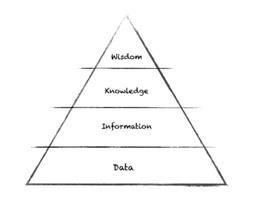Are we in danger of focusing too much on the process of creating BIM models and not enough on how the models actually affect projects?

In your mind, or on some paper, draw a triangle with a horizontal base at the bottom and two sides of equal length leading to an apex pointing directly upwards. Sub-divide the triangle into four horizontal layers of roughly equal height. In the bottom layer write the word ‘data’, then working up through the layers add the words ‘information’, ‘knowledge’ and finally in the smallest section write the word ‘wisdom’. You have created the DIKW (data, information, knowledge, wisdom) hierarchy, a diagram which has been drawn on countless flip charts and scribbled onto too many notebooks to mention.
Those amongst us who are philosophically minded may give a wry smile and note that there is rather a lot of data and little wisdom, and we may reflect back on our working lives and feel that as technology progresses, data and information near the base of the triangle seem to become ever greater and knowledge and wisdom towards the apex are becoming squeezed as a consequence.

The construction industry has traditionally failed to consistently implement an effective process and set of tools to manage and co-ordinate data and information about built assets and the projects through which these assets are created and managed. BIM should provide both the process and the tools we need. We must take care to ensure that as we adopt BIM that we don’t forget the top half of the triangle, that knowledge and wisdom are not squeezed out.
We could make a rather dangerous assumption – that through managing data and information we will in turn create knowledge, and wisdom will follow. This is often an interpretation of the DIKW hierarchy, however this does not hold true.
Knowledge stocks in the construction process are of limited value unless they are shared, and most crucially talked about by the project team
With BIM we are generating rich models with vast quantities of embedded data, the individuals who have created these models have considerable knowledge of the software used in their production, but also of the methods and information structures they used to create them. These individuals have rich knowledge of the model they have created. Both the data rich models, and the tacit knowledge held by the model creator can be described as ‘knowledge stocks’. But knowledge stocks in the construction process are of limited value unless they are shared, and most crucially talked about by the project team.
Conversations around and about the model are knowledge flows, and should take place regularly within the project team, and also with the client and key project stakeholders.
Working with BIM we can focus too much on the knowledge stocks, on the individual effort of creating a model which is beautifully constructed and rich in information. The process of model creation can become all consuming. There is also a danger that when conversation does take place this becomes diverted by challenges around software versions, compatibility, and clash detection/resolution rather than teams really talking about the project and delivering the client’s outcomes. We must ensure we spend less time talking about the model and more time using the model to talk about the project.
Adrian Malone is a director at Faithful+Gould with responsibility for BIM, knowledge management and commercial research



























2 Readers' comments